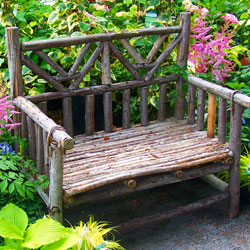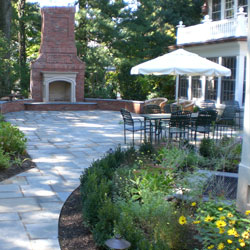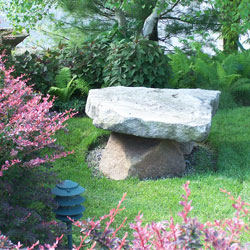We have all used focal points in our daily lives, from showcasing favorite photos in a gallery wall to throw pillows adding a pop of color on the sofa to choosing accessories to highlight our best features. But did you know you can use landscape focal points in a similar way, drawing the eye to the very best features of your home and property to accentuate its unique characteristics and highlight its beauty? Learn how to truly showcase your landscaping with the best focal points to give your home extra flair.
What Is a Focal Point?
A focal point is a highlighted, outstanding feature that draws the eye and grabs attention. In the landscape, this can be nearly any type of feature, from plants to structures to hardscaping to ornamentation. Popular landscaping focal points include…
- Unique specimen plants, either unusual varieties, unique shapes or exceptional sizes
- Water features such as ponds, waterfalls or fountains
- Boulders, terraces or other dramatic hardscape details
- A bird feeding station or other wildlife-oriented feature
- A colorful flowerbed, container garden or even a dramatic window box
- A statue or sculpture, even as simple as a gazing ball or sundial
- Inviting structures such as gates, arbors, pergolas or arches
- A seating area or other outdoor gathering space
- A uniquely designed pathway, such as a mosaic, stepping stones or bridge
- Specially designed pavers, such as a mural-like feature
A focal point can be anything unique, whether it is a naturally-occurring feature of the existing landscape or something you have dreamed of adding to your yard or garden.
The Purpose of a Focal Point
While a focal point initially draws the eye, it actually does far more than just attract attention. A well designed landscape will work with focal points to bring order and dimension to the yard, centralizing the view and directing guests’ viewpoints. A focal point can add character to the yard as well, whether it creates a sense of natural elegance, adds a chic, modern touch or even introduces a bit of whimsy to the landscape. Focal points can also help distract from less aesthetically pleasing views, such as drawing attention away from a neighbor’s yard, minimizing the appearance of a trouble spot or redirecting sightlines away from a utility box or air conditioning unit.
Choosing a Landscaping Focal Point
Which focal point you choose for your landscape will depend on several factors, and you want to consider each one carefully when planning to use a focal point.
- Yard Size: The focal point should be proportionally sized to the yard. A too-large focal point will overwhelm a small, intimate yard, making it seem more crowded and cramped, while a too-small focal point can be lost in a larger space.
- Landscape Style: A focal point should coordinate with the style of the yard and garden. A cozy cottage garden can look great when focused around a romantic statue or elegant bird bath, but a stark obelisk would look out of place.
- Seasonal Changes: Ideally, a focal point will remain attractive and eye-catching throughout the year, even with seasonal changes in nearby plants and light levels. Opt for a focal point that can be enjoyed year-round for the best results.
- Viewing Angles: A good focal point will draw the eye in a pleasing way no matter where it is viewed from, including different angles, windows or approaches. Paying attention to every viewpoint will ensure the focal point serves its purpose however it is viewed.
Once these factors are considered, a landscape may have one or more focal points. So long as they are balanced and appropriate to the yard’s design, they can be beautiful features that will be stunning highlights in the landscape.
Designing Your Landscape Around a Focal Point
Once you have selected a focal point for the landscape, it is best to coordinate the landscape’s overall design to enhance and complement that focus. This will ensure its beauty and prominence in the landscape without creating an overwhelming or dominating effect. Easy ways to design your landscape around a focal point include…
- Paying attention to symmetry to draw the eye to the focal point. You may opt for a completely symmetrical, geometric layout to lead the eye to the focal point, or choose a deliberately asymmetrical design that builds dramatically to the focus.
- Coordinate colors, plants and other features to work with the focal point rather than contrast and detract from it. Coordinated colors, shapes and textures – even when used in variety – can add to your focal point and enhance its beauty and drama.
- Highlight the focal point without blocking it from view, particularly when considering views from different angles and in different seasons. This may include regular pruning and other care to keep the surrounding landscape in check.
- Keep the focal point in good condition so it is not a disappointment when it draws the eye. Plants should be properly pruned and shaped, while statues and other accents may need regular cleaning. Structures may need regular repairs or repainting to look their best.
- Consider muting nearby landscaping features to further highlight the focal point. Opt for more subtle plants and fewer accents away from the focal point to ensure no other areas of the landscape compete with the intended focus.
- Design pathways, borders and lighting to highlight the focal point and draw attention to the appropriate space, both visually and physically. This will keep your focal point centralized in the landscape at all times, serving its purpose as your landscape highlight.
A focal point is more than just a highlight of your yard, it can become the centerpiece of your landscape, set the mood for your outdoor space and showcase the beauty of your home. Working with a focal point can help you draw together the entire space in an eye-catching way you’ll always be proud to see.
Want to design your landscape around an appropriate focal point? Our design experts can help you choose just the right focus and create a stunning look to highlight your landscape’s best features!







